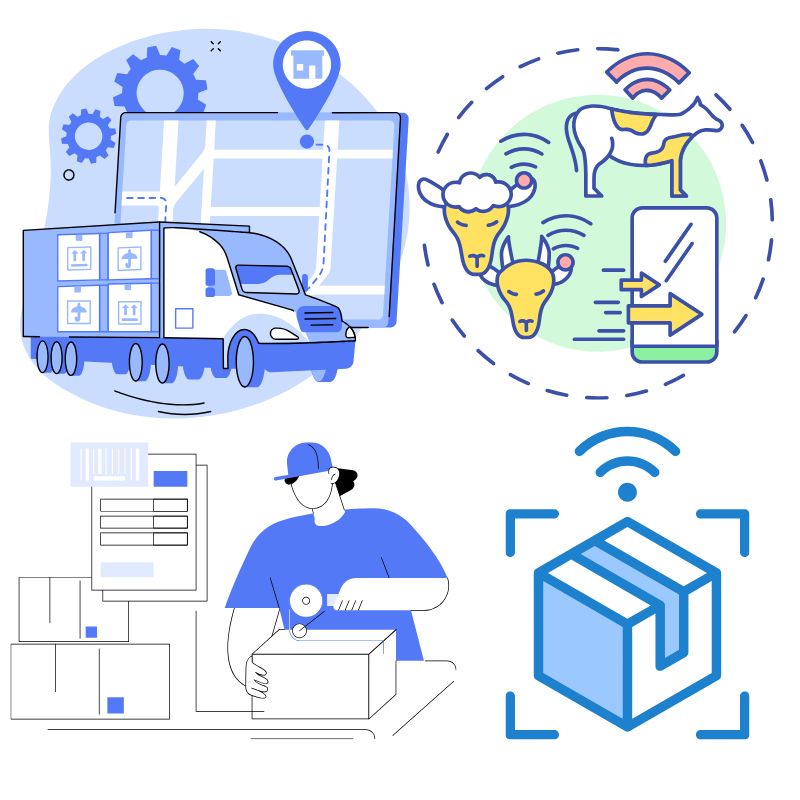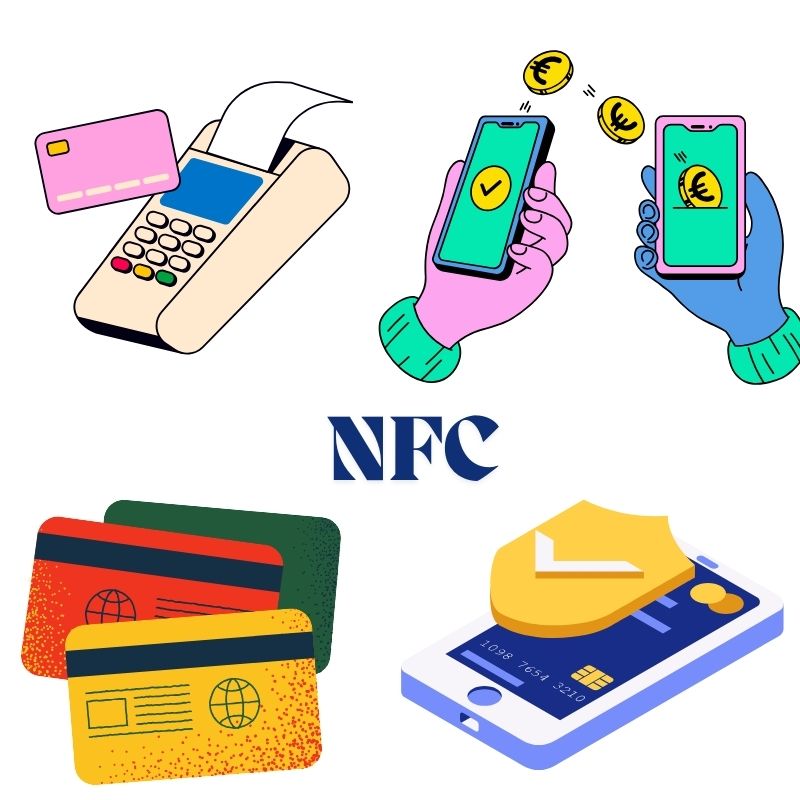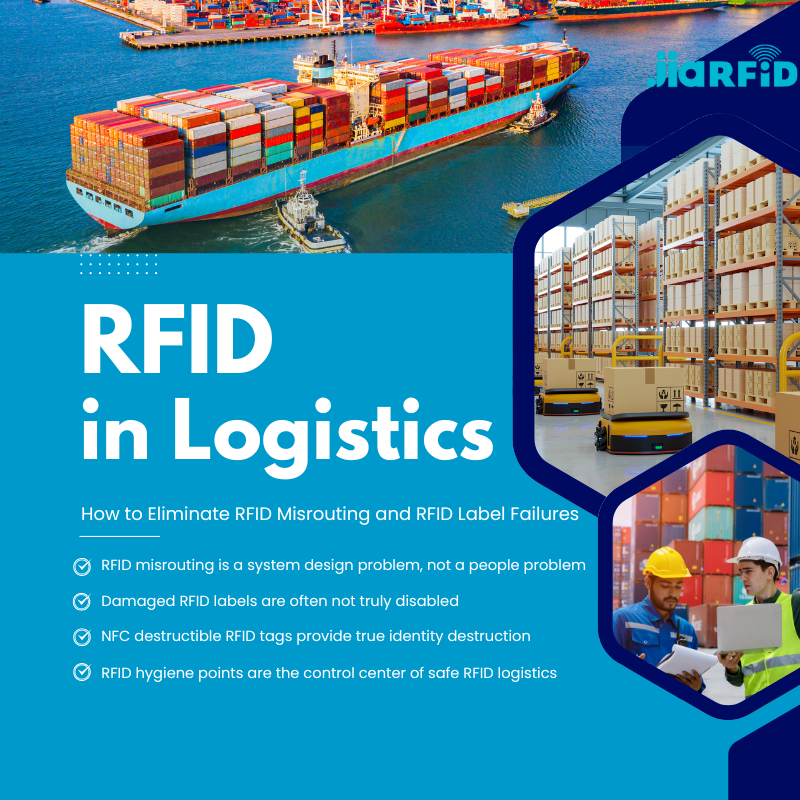
Quelle est la différence entre NFC et RFID ?
Table des matières
NFC et RFID : principales différences, applications et choix à faire (guide 2025)
Du suivi des stocks aux paiements sans contact, ces méthodes de communication sans fil aident les industries à automatiser leurs processus, à réduire les erreurs et à renforcer la sécurité.
Ce guide explique la différence entre la RFID et la NFC, leur fonctionnement, leurs applications et laquelle correspond le mieux à vos besoins en 2025.

Qu'est-ce que la RFID et la NFC ?
RFID (identification par radiofréquence)
La RFID utilise des ondes radio pour identifier et suivre automatiquement des objets grâce à des étiquettes RFID et des lecteurs RFID. Elle est couramment utilisée dans des secteurs tels que la logistique, la vente au détail, la fabrication et les soins de santé pour suivre les actifs et rationaliser les opérations de la chaîne d'approvisionnement.
- Bandes de fréquences : basses (LF), hautes (HF) et ultra-hautes (UHF)
- Portée de lecture : jusqu'à 100 mètres (étiquettes actives)
- Tags : Passif (sans batterie) ou Actif (alimenté par batterie)
- Cas d'utilisation : gestion des stocks, suivi des actifs, contrôle d'accès
NFC (communication en champ proche)
La NFC est une sous-catégorie spécialisée de la RFID, fonctionnant à 13,56 MHz (HF). Contrairement à la RFID générale, la NFC permet une communication bidirectionnelle entre des appareils situés à très courte distance, généralement moins de 4 cm. Elle est largement utilisée pour l'échange sécurisé et rapide de données, comme les paiements mobiles ou les cartes de visite numériques.
- Bande de fréquence : haute fréquence (13,56 MHz)
- Portée : quelques centimètres
- Interactivité : prend en charge la communication bidirectionnelle
- Cas d'utilisation : paiements sans contact, appairage avec smartphone, transports publics
NFC vs RFID : quelle est la différence ?
La différence entre la RFID et la NFC réside dans la portée, l'interactivité, la puissance et les applications. Voici un tableau comparatif rapide :
| Fonctionnalité | RFID | NFC |
|---|---|---|
| Bande de fréquence | BF, HF, UHF | HF (13,56 MHz) |
| Plage de lecture | Jusqu'à 100 mètres | À quelques centimètres près |
| Communication | Aller simple (principalement) | Bidirectionnel |
| Source d'énergie | Passif ou actif | Généralement passif |
| Applications | Inventaire, chaîne logistique, contrôle d'accès | Paiements mobiles, partage de données |
| Interactivité | Faible | Élevé (interaction utilisateur-appareil) |
- “ La technologie RFID est idéale pour le suivi d'actifs à grande échelle, tandis que la technologie NFC est conçue pour les interactions sécurisées à courte portée, telles que les paiements mobiles. ”
Comment fonctionne la technologie RFID
Un système RFID repose sur trois composants principaux :
- Étiquettes RFID : stockent des informations sur les articles (en lecture seule ou en lecture/écriture).
- Lecteur RFID : émet un signal pour alimenter les étiquettes passives et récupérer les données.
- Système logiciel : interprète et gère les données collectées.
Types d'étiquettes RFID
- Étiquettes RFID passives : sans batterie interne, alimentées par le signal du lecteur RFID.
- Étiquettes RFID actives : disposent de leur propre source d'alimentation pour une plus longue portée et des mises à jour fréquentes des données.
Les lecteurs RFID et NFC sont disponibles en formats portables et fixes, selon l'application.
Comment fonctionne la technologie NFC ?
La technologie NFC permet une communication à courte distance entre deux appareils compatibles NFC ou entre un appareil et une étiquette NFC.
Avantages du NFC :
- Simplicité « Tap-and-Go » : aucun appairage ni scan requis.
- Haute sécurité : idéal pour les transactions financières sans contact.
- Communication bidirectionnelle : contrairement à la plupart des systèmes RFID, les données peuvent circuler dans les deux sens.
Les lecteurs NFC et RFID sont de plus en plus intégrés aux smartphones, aux terminaux de point de vente et aux portiques de transport afin de garantir des interactions rapides, fiables et sécurisées.
Applications de la RFID
La RFID et la NFC alimentent toutes deux diverses applications, mais la longue portée et la flexibilité de la RFID la rendent idéale pour :
Gestion des stocks
- Mises à jour en temps réel
- Suivi automatisé dans tous les entrepôts
Suivi des actifs
- Surveiller les équipements médicaux, les outils ou les véhicules
- Améliorer l'efficacité dans les domaines de la logistique et des soins de santé
Contrôle d'accès
- Utilisez des cartes-clés RFID, des badges ou des porte-clés
- Contrôler l'accès aux bâtiments ou zones sécurisés
Applications de la technologie NFC
Les capacités sécurisées et à courte portée de la technologie NFC sont particulièrement utiles dans les applications personnelles et grand public :
Paiements mobiles
- Apple Pay, Google Pay, Samsung Pay.
- Transactions sécurisées en quelques secondes.
Appareils intelligents et marketing
- Appuyez pour lancer des applications ou partager des coordonnées.
- Balises intelligentes pour les informations sur les produits ou les enregistrements.
Systèmes de transport
- Cartes de transport sans contact.
- Embarquement facile dans les réseaux de métro et de bus.

NFC ou RFID : laquelle choisir ?
| Cas d'utilisation | Meilleure technologie |
|---|---|
| Suivi à longue distance | RFID |
| Opérations liées aux stocks ou à la chaîne d'approvisionnement | RFID |
| Transactions sécurisées et personnelles | NFC |
| Paiements mobiles et identité | NFC |
| Automatisation intelligente IoT | Les deux |
Si vous gérez des milliers d'actifs, la RFID est la solution idéale. Pour les interactions individuelles et sécurisées, comme le paiement par téléphone, la NFC est le choix évident.
NFC et RFID dans l'IoT (Internet des objets)
Les technologies RFID et NFC sont fondamentales pour les écosystèmes IoT, car elles permettent aux objets physiques de “ communiquer ” avec les systèmes numériques.
- RFID dans l'IoT: Surveille les marchandises tout au long des chaînes d'approvisionnement et dans les ateliers de fabrication.
- NFC dans l'IoT: Permet un appairage sécurisé des appareils, un accès intelligent à la maison et un contrôle en temps réel via les smartphones.
“ La combinaison des balises NFC et RFID transforme l'IoT en connectant les actifs physiques au cloud. ”
Le rôle de la fréquence dans les performances NFC et RFID
Comprendre la fréquence aide à choisir le bon système :
- LF (125–134 kHz) – Courte portée, utilisé dans le contrôle d'accès
- HF (13,56 MHz) – Utilisé à la fois par la technologie RFID et NFC
- UHF (860-960 MHz) – Longue portée, idéal pour les chaînes d'approvisionnement
Chaque fréquence prend en charge différentes plages et vitesses de lecture, ce qui rend le choix du lecteur RFID et NFC important pour les performances du système.
FAQ sur NFC et RFID
Quelle est la principale différence entre RFID et NFC ?
La technologie NFC est un sous-ensemble de la technologie RFID. Alors que la technologie RFID prend en charge des communications à plus longue portée et à sens unique, la technologie NFC est conçue pour des interactions bidirectionnelles à courte portée.
Les étiquettes NFC et RFID sont-elles interchangeables ?
Pas toujours. La technologie NFC fonctionne uniquement en HF, tandis que la technologie RFID peut utiliser les fréquences LF, HF ou UHF. Les balises NFC ne fonctionnent qu'avec les lecteurs NFC, et non avec tous les lecteurs RFID.
Les étiquettes RFID sont-elles sécurisées ?
Les étiquettes RFID passives peuvent être vulnérables sans cryptage. La technologie NFC offre davantage de sécurité intégrée, en particulier pour les transactions financières.
Qu'est-ce qu'un lecteur NFC et RFID ?
Il s'agit d'un appareil utilisé pour lire les étiquettes RFID ou NFC. De nombreux smartphones modernes font office de lecteurs NFC pour les actions sans contact.
Comment fonctionnent les paiements NFC ?
Les appareils utilisent la technologie NFC pour transmettre sans fil des informations de paiement cryptées à des terminaux compatibles, sans aucun contact physique.
Quels sont les secteurs qui tirent le plus profit de la RFID ?
Le commerce de détail, les soins de santé, la logistique, la fabrication et l'entreposage utilisent la RFID pour l'automatisation et la visibilité.
Réflexions finales
Les technologies RFID et NFC offrent toutes deux une valeur ajoutée significative, que ce soit pour le suivi des palettes ou pour effectuer des paiements avec votre smartphone. Votre choix doit correspondre à vos besoins opérationnels :
- Pour un suivi automatisé à grande échelle, optez pour la RFID.
- Pour des interactions sécurisées à courte portée, optez pour la technologie NFC.
Alors que les étiquettes RFID et NFC évoluent avec l'IoT, c'est le moment idéal pour les intégrer à votre flux de travail.
Vous avez besoin d'aide pour choisir le système NFC ou RFID adapté à votre entreprise ?
Contactez-nous aujourd'hui ou découvrez notre gamme complète de lecteurs et d'étiquettes NFC et RFID.

Ray Zhou
Cet article a été rédigé par Ray Zhou, un expert en technologie RFID ayant plus de 10 ans d'expérience dans le secteur.
Commentaires
- Sur les étiquettes RFID en métal
- Étiquettes de disque RFID
- Étiquettes RFID pour pièces de monnaie
- Étiquettes RFID pour animaux
- Étiquettes RFID pour bijoux
- Étiquettes RFID pour blanchisserie
- Étiquettes RFID pour bibliothèques
- Étiquettes RFID pour véhicules
- Étiquettes RFID en bois
- Colliers de serrage et étiquettes RFID pour cadenas
Produits phares

La RFID dans la logistique : comment éliminer les erreurs d'acheminement RFID et les défaillances des étiquettes RFID
La RFID dans la logistique est bien plus qu'un simple outil permettant d'accélérer les processus. Elle est devenue un élément clé du fonctionnement des chaînes d'approvisionnement modernes.

Qu'est-ce que la gestion des déchets par RFID ?
Imaginez une ville où chaque poubelle parle – pas littéralement – mais grâce à une minuscule puce qui indique au système quand elle est pleine, quand elle est vidée et où elle a été emmenée. C'est ce que fait aujourd'hui la gestion des déchets par RFID.

Qu'est-ce qu'un joint de boulon et quelles sont ses applications ? | Guide complet
Dans le cadre du commerce mondial et de la logistique, les scellés à boulon jouent un rôle crucial pour assurer la sécurité et la conformité des cargaisons. Ces dispositifs, petits mais puissants, sont conçus pour verrouiller les conteneurs d'expédition, les remorques et les portes de chargement à l'aide d'un mécanisme d'inviolabilité.

Qu'est-ce qu'un protecteur de carte RFID ? Avantages, cas d'utilisation et guide d'achat
La technologie RFID (identification par radiofréquence) est partout : dans vos cartes de crédit, vos badges d'identification, vos titres de transport, vos clés de chambre d'hôtel, etc. Elle offre rapidité et commodité, mais elle ouvre également la porte à un nouveau type de vol numérique appelé "skimming" (écrémage). C'est là qu'intervient un protecteur de carte RFID.

Bracelets RFID pour événements : Guide d'achat en gros pour les organisateurs
Les bracelets RFID pour les événements deviennent la solution de choix pour les organisateurs qui ont besoin d'une entrée plus rapide, d'une prévention de la fraude et de paiements sans numéraire lors de concerts, de festivals et d'événements sportifs. Contrairement aux billets en papier ou aux codes QR, ces bracelets intelligents utilisent des puces intégrées pour rationaliser l'accès, sécuriser les transactions et améliorer l'expérience des visiteurs.

Comment l'étiquette RFID sur le pare-brise améliore le contrôle d'accès des véhicules et les systèmes de péage
Dans le monde rapide d'aujourd'hui, l'identification des véhicules doit être rapide, sûre et sans contact. Un tag RFID sur le pare-brise offre exactement cela - un moyen fiable de gérer les péages, les parkings et les accès aux barrières sans arrêter les véhicules.
Mots clés
BLOGS CONNEXES

La RFID dans la logistique : comment éliminer les erreurs d'acheminement RFID et les défaillances des étiquettes RFID
La RFID dans la logistique est bien plus qu'un simple outil permettant d'accélérer les processus. Elle est devenue un élément clé du fonctionnement des chaînes d'approvisionnement modernes.

Qu'est-ce que la gestion des déchets par RFID ?
Imaginez une ville où chaque poubelle parle – pas littéralement – mais grâce à une minuscule puce qui indique au système quand elle est pleine, quand elle est vidée et où elle a été emmenée. C'est ce que fait aujourd'hui la gestion des déchets par RFID.

Qu'est-ce qu'un joint de boulon et quelles sont ses applications ? | Guide complet
Dans le cadre du commerce mondial et de la logistique, les scellés à boulon jouent un rôle crucial pour assurer la sécurité et la conformité des cargaisons. Ces dispositifs, petits mais puissants, sont conçus pour verrouiller les conteneurs d'expédition, les remorques et les portes de chargement à l'aide d'un mécanisme d'inviolabilité.




